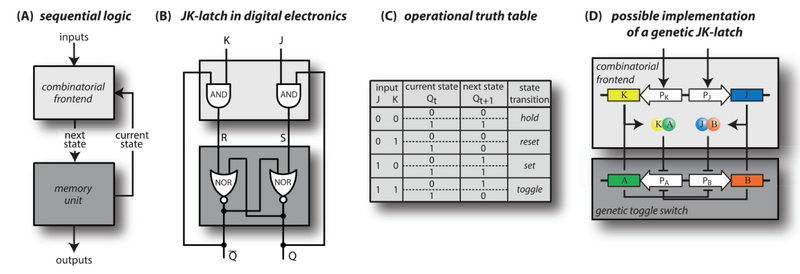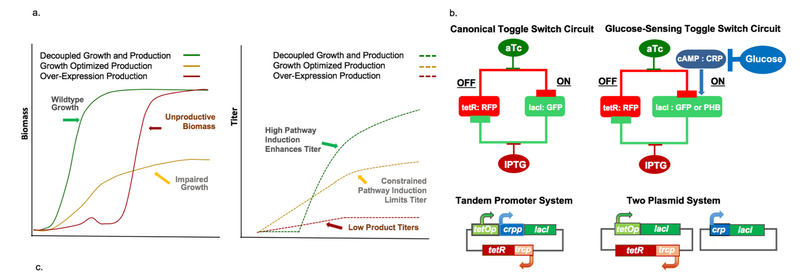User:SKaret/Notebook/GroupProj/ToggleSwitchApps
From OpenWetWare
Jump to navigationJump to search
Example 1: Use of toggle switch to make a genetic JK Latch
- Paper: Biological Signal Processing with a Genetic Toggle Switch Patrick Hillenbrand , Georg Fritz, Ulrich Gerland 2018
- Combinational logic is widely used in biological systems to integrate signals to have a regulatory effect on a gene.
- The signal processing capability of any combinatorial logic is limited as output always depends on the current continuous output.
- Sequential logic- output is dependent on memory/history.
- Genetic toggle switch consists of two mutually repressing genes- it serves as the basis for simple sequential logic.
e.g. JK Latch

Core memory unit: genetic toggle switch
- Sequential Logic in digital electronics is predominantly synchronous- ie it has a central clock that orchestrates the timing of all operations.
- Biological systems must use asynchronous logic resulting in design constraints.
Example 2
- Paper: A Glucose-Sensing Toggle Switch for Autonomous, High Productivity Genetic Control Bothfeld, W., Kapov, G. & Tyo, K.E.J., 2017.
- Currently, many bioproduction strategies rely on growth-coupled production, because constitutive expression of the product pathway is more feasible than inducing production after growth
- A decoupled growth and production phase strategy is needed for efficient economical bioproduction of chemicals.
- A toggle switch has been developed that uses glucose sensing to enable this two-phase strategy.

Idealized strategies for biosynthesis of chemicals using cell factories. (a) Common biomass (solid line) and product (dashed line) profiles expected from a variety of biosynthesis strategies (green: decoupled growth and production, yellow: constitutive growth and production, red: constitutive pathway overexpression). (b) The integration of glucose sensing into the toggle switch architecture.
A functional genetic toggle switch
- Unlike simple induction, a genetic toggle switch could enable complete activation to a new stable state that would eliminate graded induction.
- The culture could stay in the production state even after the activating condition is gone due to the memory capacity encoded by the switch
- The “new” switch state could be maintained stably during the entire production phase
Selecting Glucose Responsive Promoters
- There was need to identify promotors with strong activation due to glucose depletion.
- CRP(cAMP receptor protein) Promotors.
- Different Glucose-Responsive Promoters Have Differing Activation Characteristics
- A promoter with both a tight OFF-state and an ON-state with adequate expression during glucose-starvation is desirable
(Relevant to our project)
Advantages this has:
- IPTG is expensive
Application of this
An IGem Project uses this for PHP Production.